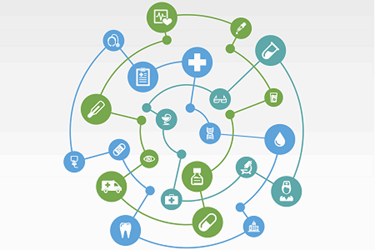Why You Should Care About Real-World Evidence (A Lot)

When the Clinical Leader team attended the 2017 DIA Annual Meeting in June, the topic we heard discussed more than any other was real-world evidence (RWE) — that is, information about a drug that is collected outside of clinical trials. RWE is not a new concept, but there are good reasons for all the current attention being paid to it in the pharma industry. For one, the 21st Century Cures Act, enacted into law in December 2016, seeks to speed the FDA drug and medical device approval processes by shifting some of the evidentiary requirements, in certain instances, from clinical trials to post-market — in other words, to “the real world.”
For this and other reasons, RWE is an area that an increasing number of CROs have moved into. So we decided to reach out to top executives at four of the largest CROs to get their perspectives on RWE and its growing importance in the industry:
- Radek Wasiak, Ph.D., VP and GM, real-world evidence, Evidera
- David Thompson, Ph.D., SVP, real world evidence and insights, INC Research/inVentiv Health
- Nancy A. Dreyer, Ph.D., SVP and global chief, scientific affairs, QuintilesIMS Real-World Insights
- Haley Kaplowitz, Ph.D., executive director, safety, epidemiology, registries, and risk management, UBC
In part 1 of this three-part roundtable Q&A, these experts share their insights on the rise of post-approval studies and on the factors driving that rise.
How much growth are you seeing in the adoption of post-approval studies?
 Radek Wasiak, Evidera: Real-world evidence, i.e., evidence derived from actual clinical practice, is used across the drug development spectrum. It is true that we are seeing a rise in the demand and execution of post-approval studies (in part because of regulatory mandates), but we also are seeing increased use of RWE earlier in the drug development process.
Radek Wasiak, Evidera: Real-world evidence, i.e., evidence derived from actual clinical practice, is used across the drug development spectrum. It is true that we are seeing a rise in the demand and execution of post-approval studies (in part because of regulatory mandates), but we also are seeing increased use of RWE earlier in the drug development process.
David Thompson, INC Research/InVentiv Health: RWE has been the fastest growing segment of clinical research for nearly five years. There is a  growing recognition of the so-called “efficacy-effectiveness gap” — the difference between how interventions work in the experimental setting (i.e., efficacy) versus how they work in conditions of typical clinical practice (i.e., effectiveness). Recognition of this gap has fueled the desire to assess how wide it is, reasons why it exists, and potential solutions. That’s the role of real-world research.
growing recognition of the so-called “efficacy-effectiveness gap” — the difference between how interventions work in the experimental setting (i.e., efficacy) versus how they work in conditions of typical clinical practice (i.e., effectiveness). Recognition of this gap has fueled the desire to assess how wide it is, reasons why it exists, and potential solutions. That’s the role of real-world research.
 Nancy Dreyer, QuintilesIMS Real-World Insights: We are seeing tremendous growth in the use of real-world studies in the U.S. and Europe, and not just to satisfy post-marketing safety commitments. Real-world studies are increasingly being used to support clinical decision-making, to generate evidence for health technology assessments, and more recently, for label expansions — both to add new indications discovered through clinical research and to broaden product labels to align with clinical use. And the growth in accessible, reliable data continues to ensure the use of RWE as a mainstay of post-approval studies for post-marketing regulatory commitments.
Nancy Dreyer, QuintilesIMS Real-World Insights: We are seeing tremendous growth in the use of real-world studies in the U.S. and Europe, and not just to satisfy post-marketing safety commitments. Real-world studies are increasingly being used to support clinical decision-making, to generate evidence for health technology assessments, and more recently, for label expansions — both to add new indications discovered through clinical research and to broaden product labels to align with clinical use. And the growth in accessible, reliable data continues to ensure the use of RWE as a mainstay of post-approval studies for post-marketing regulatory commitments.
 Haley Kaplowitz, UBC: It does seem to be the case that regulatory agencies, including the FDA, are increasingly requesting real-world post-approval studies. However, such studies have been around for a long time, and have been utilized both pre- and post-approval in the product lifecycle.
Haley Kaplowitz, UBC: It does seem to be the case that regulatory agencies, including the FDA, are increasingly requesting real-world post-approval studies. However, such studies have been around for a long time, and have been utilized both pre- and post-approval in the product lifecycle.
These studies were typically designed as patient disease or pharmaceutical product registries or cohort studies — i.e., protocol-driven observational studies that observed patient and healthcare provider (HCP) behaviors and product safety — and systematically collected relevant data without intervention or randomization. In the past, this traditionally involved recruiting clinical study sites, which then recruited their patients into the study (e.g., registry).
More recently, however, industry has been leveraging existing healthcare data sources for research purposes, primarily in an attempt to increase efficiency (e.g., lower per-patient costs, increase sample sizes, or minimize burden on HCPs/clinic staff). There has been a great deal of interest in utilizing healthcare databases, such as automated insurance claims or electronic medical records, for research. A hybrid study design combining both prospective data collection and linkage to medical records or other healthcare data sources is becoming increasingly common.
The potential to learn from such “Big Data” is large, and to some extent already demonstrated, but must be weighed against the consideration that these data sources were typically developed for purposes other than research, and careful (and sometimes new) methods must be applied to analyze and interpret these data appropriately. That said, we are seeing increasing acceptability of these approaches, both within pharmaceutical companies in order to gain insights, and, more gradually, by regulatory agencies as they become more familiar with them and appropriate analytical methodologies (via FDA’s Sentinel Initiative, among others).
For insurers to pay a premium for a new product, they want to see evidence of its effectiveness. Is this a key factor driving these studies?
Kaplowitz: Yes, evidence of a product’s effectiveness is important to insurers, particularly since the patient experience in a clinical trial is somewhat “unnatural” — insurers are looking for demonstration of value in actual clinical practice. Existing healthcare data, such as insurance claims and electronic medical records, is frequently analyzed to understand current treatment practices, unmet medical need, and burden of illness even before a new product is marketed. Once the product is marketed, and with sufficient uptake, these databases may be employed for studies of comparative effectiveness. But again, these studies are still complex and must be carefully executed in order to reach appropriate conclusions.
Wasiak: There are several dimensions to insurers’ requests for evidence from actual clinical practice. One is the realization that findings from clinical trials do not tell the whole story. When new products are adapted by a highly variable prescriber population, and prescribed to a group of patients that may not exactly meet the criteria specified in the clinical trial, the outcomes may be different than observed in an interventional trial setting. Another is the increase in data availability powered by technological advances — the volume and complexity of real-world data is growing. And last but not least, there is the issue of price. Health care systems are facing affordability issues and have to consider the value of new treatments more than ever before. As a result, payers are demanding more and better evidence of effectiveness and value in order to make access and reimbursement decisions.
Thompson: Payers are only one of several health system stakeholders interested in RWE — others include clinicians, patients (and patient advocacy groups), and outside the U.S., health technology assessment agencies. Also, don’t forget that the FDA and other regulatory authorities often require collection of real-world data following approval for purposes of continued safety monitoring — these are referred to as post-marketing commitments in the U.S. and post-authorization safety surveillance (PASS) studies in Europe.
Dreyer: The most interesting aspect of payer questions is that they generally focus on issues of comparative effectiveness and treatment heterogeneity. Does one treatment work better than another, and which subgroups are most likely to benefit or experience harm? Payers have become more sophisticated in their evidence needs as we move toward more personalized medicine. They want to see proof of effectiveness with active comparators in diverse patients treated in real-world conditions. They want comparators that are relevant to the populations they cover, which means that even clinical trials with head-to-head comparators may have less global relevance since the comparator may not be the right match for local interests.
Generating evidence to support use of expensive medicines often requires new models of conducting studies since showing the value of costly treatments for common conditions often requires large-scale studies and follow-up of 10 years or more. For joint replacements, for example, payers — along with patients, clinicians, and health systems — want to know how long the new joint will continue to function. For some costly cardiovascular diseases, we all want to know if a medication’s use will be able to alter the course of disease.
While randomized clinical trials (RCTs) are the hallmark for testing new products, they restrict variability by focusing on narrowly defined groups of patients who are treated according to a randomization schedule and clinically assessed by experts using a battery of tools that may not have clinical relevance in everyday medical practice. Alternatives, such as pragmatic randomized clinical trials (pRCTs), which don’t use placebos and focus on outcomes with more direct clinical relevance, can deliver robust, actionable information at half the cost of a classical RCT — or less. We are also starting to see pRCTs coupled with record linkage to health insurance claims and other existing data that increases their relevance for payers, and other new approaches that obtain information on benefits and risks through follow-up directly with patients, and then only obtain validation for events of special interest.
Last but not least is the emergence of the randomized registry trial, like the TASTE trial, where patients participating in a registry are invited to a randomized substudy to address issues of practical interest. All the follow-up data is collected through ongoing registry participation — a tremendously cost-effective way to obtain data assuming an appropriate registry exists, addresses the outcomes of interest, and is amenable to such use.
Part 2 of this three-part series explores how the 21st Century Cures Act raised RWE awareness and adoption in the industry, and what role RWE will play in Phase 2 and 3 clinical studies
